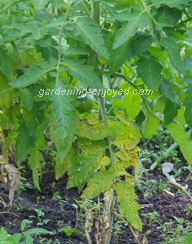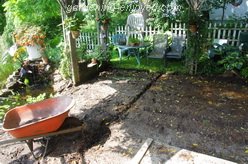| Back to Back Issues Page |
 |
|
Dallying In The Dirt, Issue #132 --- A rotten deck and other disasters July 12, 2013 |

Although much of the garden is growing at an amazing rate because of all the rain that we have been experiencing, there are some down sides. First the pleasures. The Daylilies are in full bloom and the amount of bloom is amazing. The Sugar Snap Peas and the tall late Peas are now both about half a metre above the trellis that usually supports them. While admiring the lush growth of these delights and the weeds, I have been tackling a few problems. Some were anticipated and one was a great surprise. There is a large white plastic container, courtesy of Loblaws, that has a planter at the top and the bottom lights up in a series of colours. There is a ring of LED lights in the bottom powered by a little solar panel. It looked good on the deck last summer and continued to work all winter sitting on top of the waterfall. I left it there this spring and planted it with a large Bonfire Begonia that grew from a retained tuber. It was looking truly magnificent until yesterday when I found the whole thing floating in the pond. Apparently there were some high winds and this container tends to be top heavy. After a messy fishing expedition it has had some weight added to its base and has been returned to its location. It’s a little bedraggled as the picture shows but the lights still work and it appears to be recovering.  The Tomatoes are growing like giant triffids everywhere they are planted. The ones on the Tomato Structure are almost at the top of the ropes. One new variety, Jasper, is already over the top. Now comes one of the anticipated problems. The bottom leaves of the Tomato plants are turning a nice yellow colour and starting to fall off. It’s a bit difficult to say with any certainty whether this is natural aging or the result of Early Blight a nasty fungus disease of Tomatoes. Regardless I have been cutting them off and putting them in the municipal yard waste bags. The spores of early blight can persist in the soil for a couple of years and so they would in my compost. In theory the compost bins would heat up enough to kill them but why take those chances. There is a great crop of fruit developing and none of it is showing any signs of the fungus attack. I just won’t pump out all the chemicals that are used by commercial Tomato growers, even if I could buy them. That’s one of the big reasons we grow our own.
The Tomatoes are growing like giant triffids everywhere they are planted. The ones on the Tomato Structure are almost at the top of the ropes. One new variety, Jasper, is already over the top. Now comes one of the anticipated problems. The bottom leaves of the Tomato plants are turning a nice yellow colour and starting to fall off. It’s a bit difficult to say with any certainty whether this is natural aging or the result of Early Blight a nasty fungus disease of Tomatoes. Regardless I have been cutting them off and putting them in the municipal yard waste bags. The spores of early blight can persist in the soil for a couple of years and so they would in my compost. In theory the compost bins would heat up enough to kill them but why take those chances. There is a great crop of fruit developing and none of it is showing any signs of the fungus attack. I just won’t pump out all the chemicals that are used by commercial Tomato growers, even if I could buy them. That’s one of the big reasons we grow our own.That’s my week of problems and disasters let’s look at some of yours. If you have a gardening question just ‘reply’ to this newsletter and send me your query. I try to answer most of the questions and the ones that I answer here are those that I think will have the widest interest. You can also find the latest garden updates on the front page of gardening-enjoyed.com. I try to change it every few days so check back often. Mary Asks ? Hosta... Some are very large now, should I just label them and reduce them in the spring, or is it ok to do it now? Ken Answers! Hosta are incredibly tough plants. Dig and divide whenever you have the time. It's a little better in the spring but will work now just as well. You can just take a spade and hack off a piece or you can dig the whole thing up and divide it into several pieces. Replant one and spread the rest around your garden or your gardening friends. They will wilt a bit but come right back. Water them well. Brenda Asks? You mentioned that Lilies don’t have enemies What about the Lily bug that is eating my yard of every kind of lily?? We are infested and getting worse each year . Ken Answers! Big difference between true Lilies and Daylilies. Red lily beetle is everywhere in my yard as well but they do not bother Daylilies, Hemerocallis spp. Lots of info on the web site on how to do battle with the little red beasts. Marcia Asks? I have 2 questions: My peonies have only 1 or 2 blooms and others are not blooming at all. They have been around for several yrs. What am I doing wrong? Are we supposed to cut off \ shorten the green growth on the onions that we planted from seed and then transplanted to garden for winter use? Seems there are differing opinions re this. Ken Answers! The most common cause of no bloom on Peonies is planting them too deep. They will grow beautifully but never bloom if they were originally planted with the eyes more than 5 cm below the soil surface. Best solution is to dig them up, not easy they will have big roots, and either replant the whole root or break it up into smaller pieces with 4 -6 eyes. Do this in mid to late September and they should start to bloom. The Onions, I have done both techniques, with little difference in the performance. If they have quite long shoots I would cut them back by about a third just to stop them from flopping over. 111 Trent St. W. Whitby ON L1N1L9 |
| Back to Back Issues Page |
 Many hard hours are being expended recovering from another of my early mistakes. The deck we have been enjoying for the past many years was built at ground level. I carefully, (I thought,) made the joist and stringers from pressure treated wood to prevent it from rotting. Apparently it rots just fine if it is constant contact with moist soil. I had supported them with gravel which doesn’t drain as well as I thought. Over the years a fine collection of dust, dirt and drifting organic matter had made its way between the deck boards and snuggled up to the joist. Last year a few of the deck boards started to bounce a bit and this spring many of them were attached to nothing. Rip up the deck, I can’t believe how many screws I used. Pry out what was left of the joist and then shovel out the muck, debris and gravel. The hard part of any of these projects is getting rid of all the debris. The dumpster looks good in the driveway. Next week, or the week after, I’ll tell you how I solved the problem and replaced the deck.
Many hard hours are being expended recovering from another of my early mistakes. The deck we have been enjoying for the past many years was built at ground level. I carefully, (I thought,) made the joist and stringers from pressure treated wood to prevent it from rotting. Apparently it rots just fine if it is constant contact with moist soil. I had supported them with gravel which doesn’t drain as well as I thought. Over the years a fine collection of dust, dirt and drifting organic matter had made its way between the deck boards and snuggled up to the joist. Last year a few of the deck boards started to bounce a bit and this spring many of them were attached to nothing. Rip up the deck, I can’t believe how many screws I used. Pry out what was left of the joist and then shovel out the muck, debris and gravel. The hard part of any of these projects is getting rid of all the debris. The dumpster looks good in the driveway. Next week, or the week after, I’ll tell you how I solved the problem and replaced the deck.